Mostar: A Broken Town Reunited
22 April, 2008, 03:33 am in "Bosnia and Herzegovina"
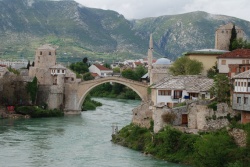 One thing about pouring rain and gray skies is they make the green countryside look even greener. As we turned inland from the beach resorts and pristine towns, and arrived in Bosnia, the towns began to look a lot less prosperous. There were many new buildings, but the awful fact was that they were replacing homes destroyed during the war. Occasionally we saw stone ruins in the distance but couldn't be sure if they were ancient or modern.
One thing about pouring rain and gray skies is they make the green countryside look even greener. As we turned inland from the beach resorts and pristine towns, and arrived in Bosnia, the towns began to look a lot less prosperous. There were many new buildings, but the awful fact was that they were replacing homes destroyed during the war. Occasionally we saw stone ruins in the distance but couldn't be sure if they were ancient or modern.The other obvious differences were the tall minarets which began to rise from the hills. As the bus reached Mostar and we passed bullet and shrapnel laced walls mixed with new or repaired buildings.
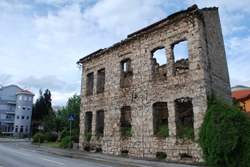
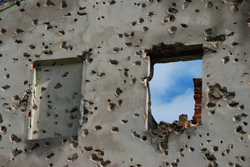
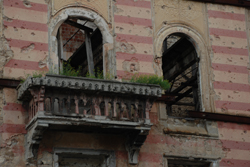
At the bus station, instead of the chaotic bidding for our accommodation Euros, each one of us was presented with a card from a different woman. When they learned we were together, one card was withdrawn, leaving us one choice. The other women all helped this woman, speaking well of her room and helping translate. Of course, we were told, if we didn't like the room we could come back and see another. After settling us in, our hostess quickly returned to the station where I assume she helped the other women find boarders. It seemed like a very positive and cooperative situation.
We walked through the town to the old part, past a building with huge blackened holes and metal structural supports twisting out like wires from a damaged machine.
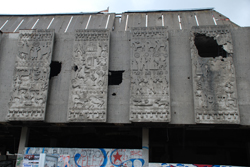
The new part of town had mostly repaired buildings housing cafes, restaurants and slick stores.
The old town was completely unexpected for me. Suddenly we were on a pedestrian street paved with rounded river stones which ran between little stone houses with roofs shingled with flagstones which from a distance resembled fish scales. Though most of the shops sold tourist kitsch, there were also some cute cafes and art galleries. Walking down the street we could hear the sound of hammers against metal, shaping the copper relief bridge pictures sold in the shops.
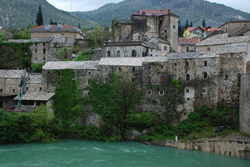
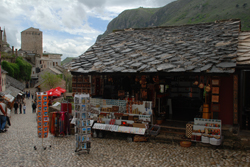
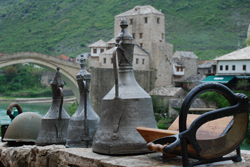
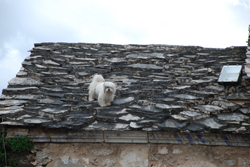
Domes of Ottoman mosques and minarets rose above the roofs. From the street level the town slipped into lush plant life which lined the river. Under the cloud cover, the river was the color of jade and rushed and boiled with the spring run off.
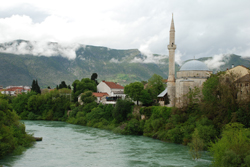
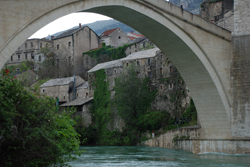
At the far end of the old town is the moon-like white arch of the ”most” (bridge) of Mostar. This iconic landmark is actually a rebuilt version of the Ottoman bridge, one of the 12 remaining in Bosnia before the war, which was destroyed. The town was quick to work together to rebuild it making it a metaphor for a community destroyed by war and how they came together afterward to rejoin the halves of the town and their lives. Young men of the town, members of the bridge diving club, would jump off the bridge in to the swift, cold water when paid enough by tour groups.
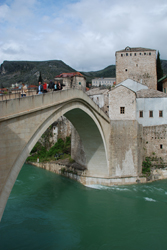
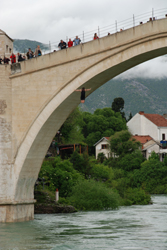
The old town looked almost as good as new, which was, in fact, true since it had mostly been destroyed during the war. The buildings had been rebuilt in the original manner. I also noticed a couple mosques which had been demolished in the 50s-60s and rebuilt after the war, as well, to look like the originals.
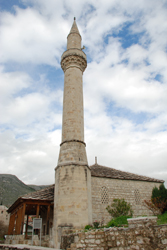
Down a quiet path, we found a miniature tributary of the river flowing to join the Neretva. Over this was a small Ottoman bridge (also rebuilt). It had a sign that said Luxembourg had restored it. Other buildings had signs that a Swedish organization had rebuilt them.
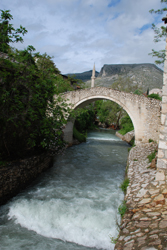
Though the city is still very scarred, it looks like it is healing. People seemed very kind and friendly. It was tempting to stay just for the atmosphere, good food, and great Turkish coffee and baklava.
On one street we found a bombed and ruined building with a spray painted picture of Cartman (from South Park). “Oh my God! They killed Kenny!” was scrawled above showing that someone in town had a dark sense of humor.
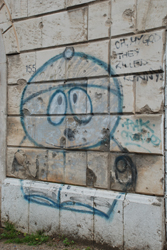
We saw a hill with a trail up it. Since Mostar was a war zone, hiking in areas without commonly used trails is not recommended due to the possibility of mines or undetonated shells.
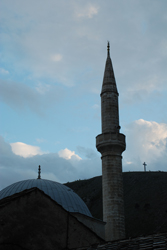
The trail had a path through the weeds so we determined it was actively in use and would give us a nice view of the town. Rowshan was about to cut across some property to get to the path when I noticed red tape that said “Mine!” Grabbing Rowshan, I pointed this out. He in turn pointed out that it was an occupied apartment building and the tape was in fact covering a hole in a fence where a car had driven off the road. “They probably had extra.” I considered that it could also mean, “Mine!” as in “Not Yours!”. Either way, we decided it was better to go around to the path via the road.
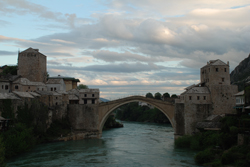
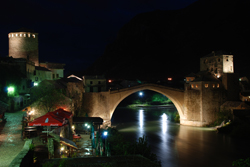
[ View 1 Comments
|
]
Comments
richard massey -
posted on 6/3/2008
Hey, Tamia. I'm really enjoying your trip. It seems like you and Rowshan really have a good feel for the road and all its joys. Just wanted to let you know that I've followed the journey and that I love all the pictures. I have the one of Prague at sunset as the wallpaper on my desktop. I was there in 2004 and thought it a beautiful city. I'm glad you made it back to Bohemia, even if some of the commercialism got you down a bit. The photograph of you two playing music in Avignon was incredible. You will truly cherish this trip for the rest of your life. Good luck and be safe.
Powered by My Blog 1.69. Copyright 2003-2006 FuzzyMonkey.net.
Created by the scripting wizards at FuzzyMonkey.net..
(Code modified by Rowshan Dowlatabadi)
Created by the scripting wizards at FuzzyMonkey.net..
(Code modified by Rowshan Dowlatabadi)

